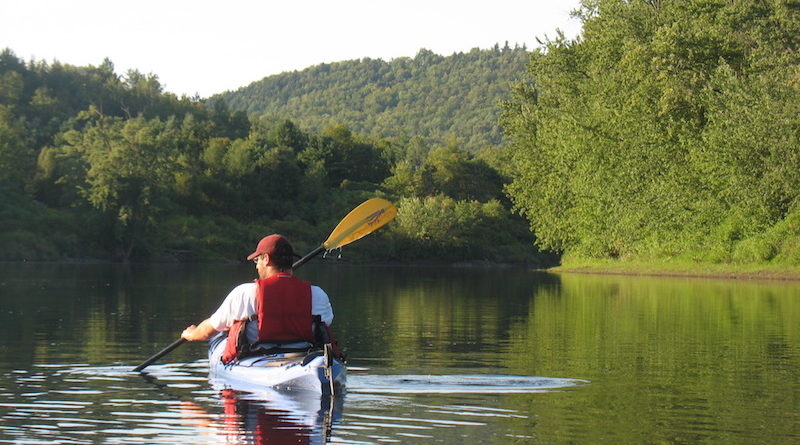Migrations
A 250-mile paddle down the Connecticut River, following the flight path of eagles.
BY LEATH TONINO
We saw our first bald eagle about an hour into the trip. Dad was in the bow, I was in the stern, the light was gold, the evening calm. The eagle soared high overhead, maybe 200 feet up, and for a moment I mistook it for a turkey vulture. Turkey vultures fly with their wings in a dihedral, a distinct V-shape, and they wobble and teeter. This bird’s wings were broad and flat, like a plank across its back, and its flight was stable. We pulled our paddles from the water and rested them on our laps. The eagle drifted through the sky. The paddles dripped.
A mile later, on a long curve through a cornfield, the light lower, the shadows longer, the evening gone from calm to calmer, we saw our second eagle. It was standing on a sandbar at the foot of a steep bank, an immature bird, all dark, no white head or tail. Bald eagles don’t “go bald”—that is, they don’t come into their adult plumage—until they’re four or five years old. They’re a long-lived species; a wild bald eagle in Alaska lived 26 years, and one in captivity died at 38. As we drew closer, Dad turned slightly in his seat, and that was enough—the eagle spread its wings and lifted into flight.
The river has a way of blending things, a way of flowing the hours and anecdotes and images together. Said differently: I forget the third eagle. I know it only as a tick mark on the inside cover of my journal, a running tally I kept during our week paddling Vermont’s eastern edge.
The trip was 250 miles, Canaan in the far north to Vernon, near the Massachusetts border. It was red foxes, anglers, covered bridges, rapids and riffles, oxbows, beavers, crooked docks, party barges, dams and reservoirs, birds of all kinds. There were belted kingfishers fishing and black phoebes flicking their tails. There were green herons with bright orange legs and great blue herons the color of smoke. Mergansers and mallards churned the water as they gathered speed to fly. Bank swallows swooped and swerved. Canada geese honked. Downy woodpeckers tapped trunks. Warblers flashed left and right, too quick to name. And there were eagles too, lots of them, far more than we’d expected.
The fourth arrived an hour after sunup. Dad was disassembling the tent in a meadow of clover and I was down by the water drinking instant coffee, standing barefoot in the shallows, pine needles and yellow pollen and little bubbles drifting past my shins. The eagle flew in from the north and headed downstream, disappearing around a bend only to return five minutes later with a fish in its talons. While bald eagles will eat waterfowl, shorebirds, small mammals, turtles, and carrion, fish generally make up more than half their diet. They’re “still hunters,” meaning they mostly hunt from shoreline trees. I drained the last of my coffee and the eagle flew past, probably en route to some favorite perch, likely a white pine with a good view.
Counting, counting, counting. The fifth was on a dead limb leaning over the river, maybe resting, maybe watching for bass, maybe both at once; it’s impossible to say where an eagle draws the lines between such activities, or if it draws lines at all. The sixth was riding a thermal, as was the seventh, the same thermal, the two of them spiraling into the blue, one above the other. The eighth was hunched in the rain, the ninth hunched in noontime sun. I can’t remember the tenth—another mystery tick mark in my journal—but I do recall the eleventh. It was harassing an osprey, trying to cadge a meal by forcing the osprey to drop its catch. This is not uncommon. Bald eagles weigh close to ten pounds, ospreys only three and a half, and the two species compete for prime habitat, the larger bird often ousting the smaller. After a couple minutes of chasing and veering and near collisions, the fish fell—a tiny silvery bomb. The eagle retrieved it from the water and the osprey flew off in the opposite direction.
Each day of our trip we crossed paths with at least one eagle, if not three, four, five, or eight. Many of these were surely repeats, the same birds looping back on us as we worked our way south. Eagles climbing the clouds; eagles flying low over their own reflections; eagles diving toward the river’s surface, slashing it with the tips of their talons; eagles that wouldn’t stir, their composure perfect, taut. Occasionally, a large fast shadow cut over the canoe and drew our attention up from the water. One time we heard what my Sibley Field Guide to Birds of Eastern North America describes as “weak, flat, chirping whistles,” and though we never found the bird, we knew it was nearby. We saw a nest of sticks. We saw a molted feather. There were even eagles in my dreams at night, flying through my unconscious, wild as ever and totally huge.
A week tracing Vermont’s eastern border. A squiggly line, a home for birds. An arithmetic of place. Three eagles plus three eagles doesn’t equal six eagles. Rather, it equals the river and the mind’s fluid passage through the river corridor. Equals awareness. Equals an awareness of the lives that make the larger life we call Vermont. I kept my journal nearby, my pencil at the ready, my binoculars dangling from my neck. Around any bend there might be another eagle for the count, another eagle to watch and wonder over and, later on, to remember.
Leath Tonino is author of One Thousand Miles, essays on his journeys in Vermont.
Featured Photo: courtesy the Northern Forest Canoe Trail. The Connecticut River starts life in Quebec and remains quiet as it flows through the Northeast Kingdom.

